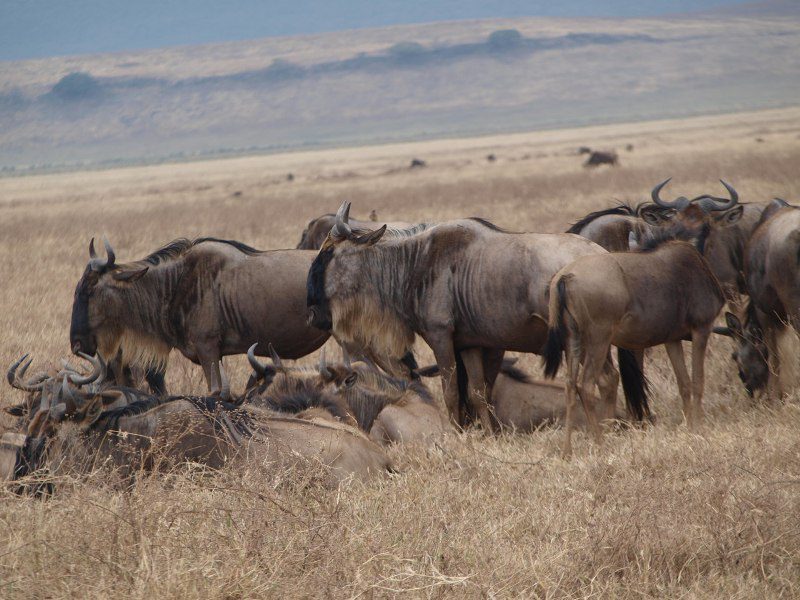Serengeti Wildbeast Migration is the best ever tourism destination in northern circuit apart from Ngorongoro crater. This migration lies at the heart of the Serengeti ecosystem, an ancient phenomenon that is the world largest mammals migration. In pursuit of pasture and water, over one and a half million wildebeest and half a million zebra and antelope migrate north from the Serengeti ecosystem to the adjoining Masai Mara National reserve in Kenya every year.
December to March
Vast herds of wildebeest spend the rainy season in the volcanic open plains below the Ngorongoro Crater and in the Southern Serengeti where the grass growth is most productive with a high nutrient content. This area is the starting point for one of the great wonders of the world: the Serengeti annual Wildebeest migration.
The grass provides little cover and the young are easy pickings for a variety of predators. Wildebeest have therefore evolved synchronized birthing, which means; about 92% of calves are born within a three-week period. With such a sudden and massive surge of available food, predators do not make any significant dent in the newborn calf population. Wildebeest calves can run minutes after they are born. Within three to four days the calves are strong enough to start the traditional migration routes.
April to May
When the grass becomes taller the herds move to the Southern plains and woodlands of the Serengeti’s Western Corridor. For the migrants there is a high mortality rate due to injury and perhaps fatigue, so large numbers of Vultures follow the herds on their traditional routes. Northwest from the short grass plains is the Grumeti River. This watercourse is their first real obstacle and gigantic Nile crocodiles (growing up to 6 meters in length) are waiting for the hesitant wildebeest to stumble at the crossing. Their livelihood are inextricably linked with the great migration. Moving with surprising stealth and speed, they prey upon the thirsty herds as they drink from and cross the rive
June
Following the rainfalls, the migration moves north before crossing the Kenyan border into the Masai Mara. Nothing stops the stampeding hordes. Here again, they must cross the Mara river, this time the Mara river with its flotillas of hungry crocodiles. All is far from peaceful, for it is the rutting season and each male tries to establish a stamping ground. After moving westwards, the migration divides by some uncanny instinct, one group turning northeast and other north.
July, August, September, October
The mass of grunting wildebeests remain on the productive Mara grasslands until October or November during a time when the rest of the ecosystem is simply too dry to support them. And then, as the storm clouds gather in the south, the vast herds return to their breeding grounds, which, by the time they arrive, are one more time again green pastures occurred in Serengeti ecosystem.
November
NOVEMBER The arrival of the short rains call the migration southward, During the short rains of November the wildebeest migration is best viewed from either Lobo Wildlife Lodge or Klein’s Camp. Campsites in the Lobo area are best.
As November ends the migration is making its way back to the southern Serengeti and early in the year they once again give birth. The circle of life is complete.
*Note – the migration is a natural event and the timing varies month by month; year by year
Safari Pricing Terms
Price includes the following:
- Full board accommodation whilst on safari in the above mentioned en suite tented camps and lodges
- Private safari guide
- Extended Toyota Land Cruiser
- Private 4 x 4 safari jeep with pop up roof for game viewing
- Transfers in both directions between the International Airport
- Park fees
- Crater fees
- All meals while on safari
- Airport Arrival/Departure Meet and Greets at the airport
- On safari – Vehicles equipped with ice chest with mineral water, wildlife guidebooks
- Government taxes, VAT and service charges relating to accommodation and included meals
Price Excludes the following:
- Tanzania Visa: $50 per person on arrival, USA and CANADA passport holders USD.100
- Personal Expenses (e.g. laundry, telephone, beverages, etc.)
- Meals not listed above
- Optional Tours (balloon rides USD. 500 per person, etc)
- Tips and any items of a personal nature.

